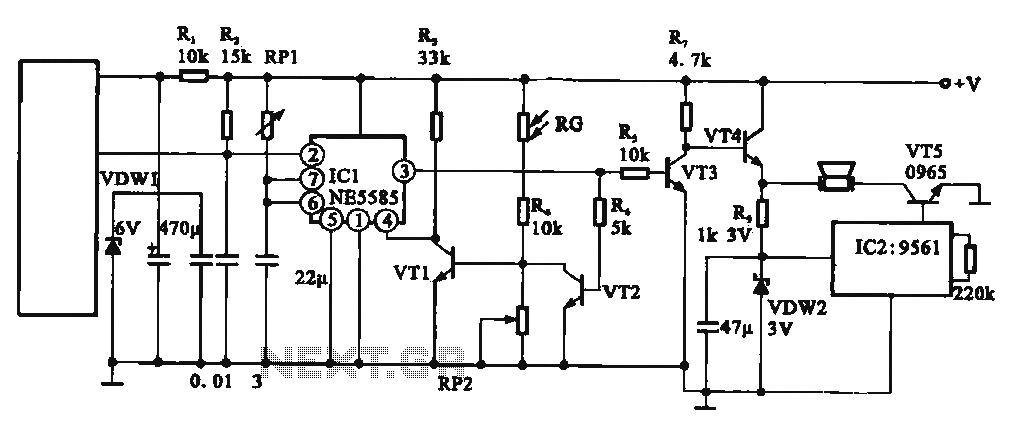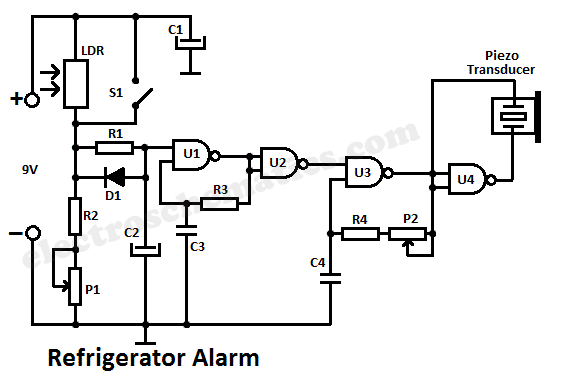
Automated Attendant burglar alarm circuit

This circuit illustrates an automatic unattended burglar alarm system designed primarily for residential use, warehouses, and similar applications. The circuit features a pyroelectric infrared sensor integrated with a light control mechanism. It comprises components such as resistors (RG, RP2, R4), an alarm driving circuit (IC2, along with additional external components), and others. During daylight hours, when light intensity is high, the photoresistor RG exhibits low resistance, activating transistor VT1, which effectively disables the alarm circuit. Conversely, at night, the resistance of RG increases, turning off VT1 and preparing the system to enter an alarm state. If an intruder enters the detection area of the pyroelectric infrared sensor, it triggers IC1, which activates the buzzer alarm.
The automatic unattended burglar alarm circuit is designed for effective intrusion detection in various environments. The primary component, the pyroelectric infrared sensor, detects motion based on changes in infrared radiation, which is emitted by warm bodies, such as humans. The sensor's output is connected to an integrated circuit (IC1), which serves as the processing unit for the alarm system.
The light control circuit is critical to the operation of the alarm system, as it prevents false alarms during the day. The photoresistor RG is strategically placed to monitor ambient light levels. When the light intensity exceeds a certain threshold, RG's resistance drops, allowing current to flow through the base of transistor VT1, which subsequently turns on and short-circuits the alarm circuit, preventing it from activating during daylight hours.
At nighttime, the resistance of RG increases significantly, causing transistor VT1 to turn off. This transition prepares the circuit to enter an alert state. The pyroelectric infrared sensor remains vigilant, constantly monitoring for any movement within its detection range. If an intruder is detected, the sensor sends a signal to IC1, which activates the alarm driving circuit (IC2). This circuit typically includes a buzzer or siren, which emits a loud sound to deter the intruder and alert nearby individuals.
For optimal performance, the circuit may include additional components such as capacitors for filtering noise, diodes for reverse polarity protection, and possibly a power supply circuit to ensure stable operation. The overall design emphasizes reliability and ease of installation, making it suitable for both residential and commercial applications.It shows an automatic unattended burglar alarm circuit, mainly for family night, warehouses and other occasions automatic unattended. The circuit consists of pyroelectric infrared sensor light control circuit (RG, RP2, R4), the alarm driving circuit (IC2 and foreign components) , and the like. At higher light intensity during the day, low resistance state photoresistor RG, the transistor is turned on VTI, the alarm circuit shorted: In the night -RG resistance value becomes larger, VT1 off, ready to enter the stage alarm circuit alarm state, when someone enters the pyroelectric infrared sensor probe measured area, ICI foot is triggered, the buzzer alarm.
The automatic unattended burglar alarm circuit is designed for effective intrusion detection in various environments. The primary component, the pyroelectric infrared sensor, detects motion based on changes in infrared radiation, which is emitted by warm bodies, such as humans. The sensor's output is connected to an integrated circuit (IC1), which serves as the processing unit for the alarm system.
The light control circuit is critical to the operation of the alarm system, as it prevents false alarms during the day. The photoresistor RG is strategically placed to monitor ambient light levels. When the light intensity exceeds a certain threshold, RG's resistance drops, allowing current to flow through the base of transistor VT1, which subsequently turns on and short-circuits the alarm circuit, preventing it from activating during daylight hours.
At nighttime, the resistance of RG increases significantly, causing transistor VT1 to turn off. This transition prepares the circuit to enter an alert state. The pyroelectric infrared sensor remains vigilant, constantly monitoring for any movement within its detection range. If an intruder is detected, the sensor sends a signal to IC1, which activates the alarm driving circuit (IC2). This circuit typically includes a buzzer or siren, which emits a loud sound to deter the intruder and alert nearby individuals.
For optimal performance, the circuit may include additional components such as capacitors for filtering noise, diodes for reverse polarity protection, and possibly a power supply circuit to ensure stable operation. The overall design emphasizes reliability and ease of installation, making it suitable for both residential and commercial applications.It shows an automatic unattended burglar alarm circuit, mainly for family night, warehouses and other occasions automatic unattended. The circuit consists of pyroelectric infrared sensor light control circuit (RG, RP2, R4), the alarm driving circuit (IC2 and foreign components) , and the like. At higher light intensity during the day, low resistance state photoresistor RG, the transistor is turned on VTI, the alarm circuit shorted: In the night -RG resistance value becomes larger, VT1 off, ready to enter the stage alarm circuit alarm state, when someone enters the pyroelectric infrared sensor probe measured area, ICI foot is triggered, the buzzer alarm.





